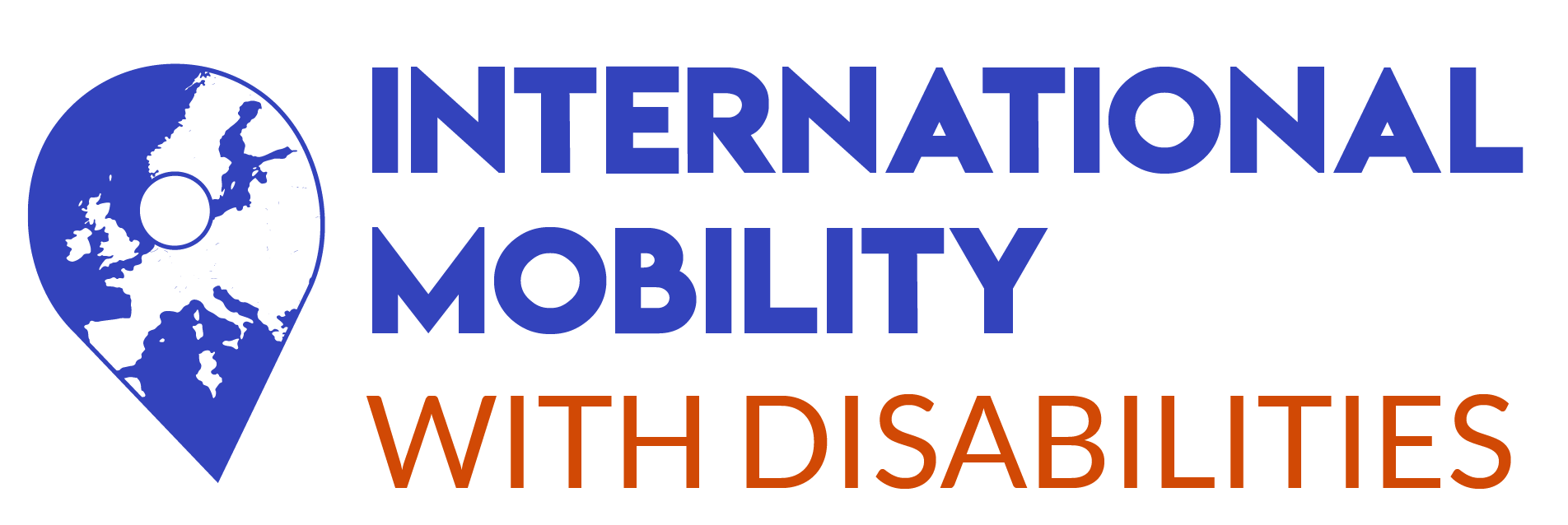
FOR YOUTH WORKERS & ORGANIZATION

Support a young person with disability
Support a young person going abroad
This page provides information on the types of mobility possible, the steps to take before going on a mobility trip and the host structures in order to make an informed choice. For more information, the toolbox of the platform is available.
1. Define the mobility project with the young person
As a youth worker preparing an international mobility for a group of young people, anticipation and understanding of the specific needs of each individual are essential.
It is important to underline that all young people, with or without disabilities, must be taken into account in their uniqueness when developing programmes and activities, in order to make mobility adapted and enjoyable for all.
In order to ensure universal accessibility to mobility, youth workers should be aware of all the specific needs and accommodations required by young people with disabilities. These young people are often accompanied by several entities (family, carers, services, institutions), which is a real asset for identifying needs and shaping an adapted experience, but we must not forget the main person concerned: the young person himself/herself.
It is essential to build the project with the young person and to identify potential constraints together. These discussions are all the more essential as they also allow the young person to be a real motor of his/her international mobility and to calmly set out their expectations. Recurring or daily arrangements in the home country can be completed in a new environment:
For example, a young person who does not usually need a note taker in his or her native tongue may need one abroad to follow the lessons more easily; this need is new and must be established well in advance in order to organise the arrangements on site. In preparing for this mobility, all parts of the programme must be adaptable. The key words for a successful inclusive mobility are anticipation and co-construction.
Anticipation because (depending on the disability situation) the needs can sometimes be heavy or call for local services without real international harmonisation. By addressing the issues of transportation and accommodation, depending on the disability situation, the choices can be quickly restricted depending on the destination (availability of PRM rooms or ground floor rooms, reservation of vehicles or adapted transport services, etc.). It is important to know whether a carer or one or more carers will accompany the young person to the destination.
Co-construction because each activity or outing planned during the mobility must ensure equal participation of young people. The programme must be designed taking into account the needs of all. Obviously, the buildings’ accessibility must be checked once again, but the tiring nature of the activities must also be taken into account. Be careful not to overload the days and allow for breaks and quiet time when necessary. Depending on the composition of the group and the number of participants, several route options may be proposed to ensure that the pace of each participant is adapted.
Keep in mind that some countries are not yet very accessible, so choose destinations where services and buildings are more adapted to the needs expressed.
Please refer to the section 2. Getting ready, for more information.
2. Inform about the hosting country, mobility program and structures
There are different types of international mobility, from short to long term mobility, young people can go abroad to continue their studies, to do voluntary work, to do an internship or to find a job. These different possibilities can be found on the Eurodesk et Youth Portal websites.
The first thing to do is to give the young person with a disability the confidence to travel (communicate, exchange as much as possible by transmitting mobile contact details, e-mail, etc.) and to help him or her plan everything so that he or she is reassured and confident, particularly with regard to all the administrative procedures relating to his or her mobility: which support organisations are available, the various possible mobility programmes, and to obtain as much information as possible about the host structure.
Ensure that this young person has all the necessary information on his or her future destination (culture, language, currency, administrative papers, transport, etc.). This includes knowing what to expect in the host country. Not all countries have the same view of disability, and while some countries are very knowledgeable on the subject, with teachers and an administration trained in the issue, other countries are less so. It is important to find out what measures exist in the country (in terms of accessibility, for example).
The way disability is perceived in the country is an important factor, the young person should know what to expect in order to facilitate his/her integration. Whether it is the other students, the administrative or medical staff, all parties have a different way of doing things and this can, in some cases, destabilise the young person. Questions of interculturality and disability should be discussed with him or her beforehand. To find out about the culture of the country, accessibility and the perception of disability, you can refer to the map and contact the relevant structures.
Therefore, the next step is to contact the structures in place in the host country to get as much information as possible. What structures exist in the host country or city to enable better integration? It is important to make an inventory of the medical structures but also of the local associations, university associations etc… For that we invite you to take note of the map. Another list of contact is also available in the ToolBox.
Finally, it is important to ensure that the young person is psychologically and mentally prepared for departure. Going on a mobility programme can be difficult for someone who will have to adapt to a new context, without his or her family and friends to support him or her on a daily basis. It is essential to discuss this with the young person, as it will help him or her to better plan ahead and find solutions to keep in touch with his or her family. Beforehand, it is important to ensure that the young person knows how to use certain technological tools (applications for video-conferencing, social networks, etc.).
3. The administrative procedures
If you are organising an international mobility with one or more young people with disabilities in your group, the most important thing is to plan each stage of the trip with each young person (sometimes also with the help of the family or carers). The young person must remain the main actor. Depending on the type of mobility proposed, the young person will be more or less supervised by various structures, especially on his or her arrival. It is important to deal with each mobility on a case-by-case basis to avoid any stress.
The challenge of a good support system lies in anticipation especially when it is the young person’s first experience of international mobility. Beyond his or her motivation, it is important to try planning ahead in order to identify all the necessary arrangements or support throughout the stay.
Accessibility:
Depending on the country and the city where the mobility will take place, accessibility may be strongly impacted. The location of the accommodation, its accessibility standards, the public transport network, the state of traffic in the streets… all these elements must be taken into account.
If it is possible to contact a local association, this can be a great advantage in order to identify the key contacts on site with them. If the young person is already a member of an association in his or her country, find out if the association does not already have partnerships in the host country. Some local authorities, such as the equivalent of town halls, have disability services and can also provide information.
In the field of transportation:
Depending on the type of transportation used for the international mobility (plane, train, bus, etc.), specific requests exist to ensure a trip adapted to the disability, do not hesitate to contact the companies. They are required to provide a service accessible to all their passengers, subject to prior request. If the student requires adapted transportation on site, you should also inquire well in advance to ensure the reservation of a vehicle.
In the field of health:
A few small tips will make mobility more serene : make sure that the student has requested a European Health Insurance Card beforehand (if he or she is moving within the European Union) to ensure that he or she will be reimbursed for health care expenses on site. Make sure that the student plans to take all prescriptions with him/her (translated if possible). Make sure that the student has all his/her medications or treatments with him/her, if possible in addition in case of emergency. A medical kit must be explicitly identified if the young person is accompanied during his/her mobility.
Please note that you should inform the transport companies if the young person is traveling with certain treatments, as they may require a special certificate. Make sure that the young person has made arrangements with his or her mutual health company and/or insurance company to ensure that he or she is properly covered during the mobility period, particularly if equipment rental is required on site or if a wheelchair, for example, is travelling in the contract. Identify with the young person the emergency contacts, whether family or medical, in his/her country of origin.
The young person may be accompanied by one or more caregivers or life assistants. It is essential to calibrate the mobility according to the specific needs of the young person. This is all the more important if the sending organisation manages the financial aspect of the project and has to include in its budget the cost of accommodation and/or the need for human assistance.
It is paramount that the sending structure is in close contact with the host structure in order to plan as much as possible the needs identified during the preparation of the mobility with the young person and the application of these needs by the host structure.

